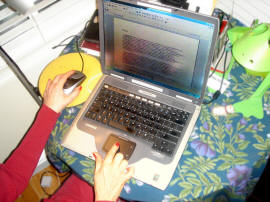Already in 1985 I was going nuts moving my mouse back-and-forth, back-and-forth between the text of the document that I was writing and the scroll bars off to the side. No matter what you wanted to do (other than type) you almost always had to do it with just one hand, the one holding the mouse. It was as if the user interface was designed for Napoleon Bonaparte (just think of the prototypical image of him with one hand tucked in his jacket). Using just one hand to do things seemed disruptive, a waste of time and energy, and just wrong. In the “everyday” physical world, for example, one would use a finger of the one hand to keep ones place in a text book, and the other to hold a pencil and write into a notebook. Or, one would turn pages with one hand, and write with the other.
It struck me that computers should work the same way. If they were so smart, why couldn’t they adjust to my skills and behaviour, rather than forcing me to adapt to theirs?
So what a student, Brad Myers, and I did was equip a computer with two devices, a touch pad and a mouse. Then, one pointed at things with the mouse as normal. But, by sliding a finger of the other hand across the surface of the touch pad, you could scroll the document on the screen up/down, left/right, or diagonal (something you still can’t do with scroll bars). We ran a formal experiment and it was clear that people could do this immediately, and furthermore, beginners using the two handed technique our performed experts using the conventional one-handed mouse-only technique.
Twenty years later, things haven’t changed. Which should make you wonder every time that you have a mouse plugged into your touch-pad equipped laptop, “Why can’t I take advantage of that second device that I have already paid for, much less use that second hand that I was born with?” You might even ask, "Why can I only scroll vertically or horizontally instead of diagonally?"
As the following table explains, taking advantage of the touch tablet for navigation would support a rich, natural and effective way to find our way through documents, without taking our eye off of our work, and without needing to divert our hand/mouse over to the scroll bars.
| Smooth scrolling | touch-slide-release | sliding the finger over the touch surface causes the document to scroll synchronously in the direction of tile motion (e.g., up or down, side to side), at a speed directly related to the speed of the motion, and by an amount determined by the amount of the motion; this gesture mimics pulling the document with finger; |
| Page turning | touch-rapid flick-release | a single rapid flicking motion over the touch surface causes the document to move in the direction of the flick by one page; this gesture mimics lifting/turning the page of a book; |
| Jumping to location | Touch-release | touching the touch surface in a position that is relative to a page location within the document, for example, the top of the touch surface could correspond to the beginning of the document. |
It took 30 years from the time the mouse was invented to the time that it became ubiquitous. So, I still have 10 years to get this two-handed stuff accepted. I will.
For more information see (Note the video):
- Buxton, W. & Myers, B. (1986). A study in two-handed input. Proceedings of CHI '86, 321-326.[video]
- Buxton, W. (1994). Two-handed Document Navigation, Xerox Disclosure Journal, 19(2), 103-108.


